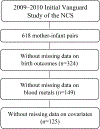Prenatal exposure to multiple metals and birth outcomes: An observational study within the National Children's Study cohort
- PMID: 33422966
- PMCID: PMC7855942
- DOI: 10.1016/j.envint.2020.106373
Prenatal exposure to multiple metals and birth outcomes: An observational study within the National Children's Study cohort
Abstract
Background: Prenatal exposure to metals may play an important role in fetal growth. However, the epidemiologic evidence for certain metals is sparse, and most of the existing research has focused on evaluating single metals in highly exposed target populations.
Objectives: We evaluated associations of cadmium, lead, manganese, selenium, and total mercury exposures during pregnancy with fetal growth using data from mother-infant pairs participating in the National Children's Study.
Methods: Prenatal metal exposures were measured using maternal blood collected from 6 to 32 weeks of gestation. Birth outcomes, including gestational age, birthweight, birth length, head circumference, and ponderal index, were ascertained through physical measurement at birth or abstraction from medical records. Regression coefficients and their 95% confidence intervals were estimated from multivariable linear regression models in the overall study population as well as among male and female infants. We further evaluated pairwise metal-metal interactions.
Results: Sex-specific associations were observed for lead, with inverse associations for birthweight, birth length, head circumference, and gestational age observed only among female infants. Sex-specific associations were also observed for selenium, with a positive association for birthweight observed among male infants; selenium was also positively associated with ponderal index and inversely associated with birth length among female infants. Overall, total mercury was inversely associated with birthweight and ponderal index, and the association with birthweight was stronger among female infants. No significant associations were observed with cadmium and manganese. In the metal-metal interaction analyses, we found evidence of a synergistic interaction between lead and total mercury and antagonistic interaction between selenium and total mercury with selected birth outcomes.
Conclusions: Our findings suggest that prenatal exposure to metals may be related to birth outcomes, and infant sex may modify these associations.
Keywords: Birth outcomes; Fetal growth; Metal mixtures; Prenatal exposure; Sex.
Copyright © 2020 The Authors. Published by Elsevier Ltd.. All rights reserved.
Conflict of interest statement
Figures
Similar articles
-
Individual and mixed metal maternal blood concentrations in relation to birth size: An analysis of the Japan Environment and Children's Study (JECS).Environ Int. 2022 Jul;165:107318. doi: 10.1016/j.envint.2022.107318. Epub 2022 May 23. Environ Int. 2022. PMID: 35679738
-
Association between prenatal arsenic exposure, birth outcomes, and pregnancy complications: An observational study within the National Children's Study cohort.Environ Res. 2020 Apr;183:109182. doi: 10.1016/j.envres.2020.109182. Epub 2020 Jan 24. Environ Res. 2020. PMID: 32058141 Free PMC article.
-
Prenatal exposure to heavy metal mixtures and anthropometric birth outcomes: a cross-sectional study.Environ Health. 2022 Dec 29;21(1):139. doi: 10.1186/s12940-022-00950-z. Environ Health. 2022. PMID: 36581953 Free PMC article.
-
Association of blood mercury levels during pregnancy with infant birth size by blood selenium levels in the Japan Environment and Children's Study: A prospective birth cohort.Environ Int. 2019 Apr;125:418-429. doi: 10.1016/j.envint.2019.01.051. Epub 2019 Feb 8. Environ Int. 2019. PMID: 30743147
-
Omega-3 Fatty Acids and Maternal and Child Health: An Updated Systematic Review.Evid Rep Technol Assess (Full Rep). 2016 Oct;(224):1-826. doi: 10.23970/AHRQEPCERTA224. Evid Rep Technol Assess (Full Rep). 2016. PMID: 30307735
Cited by
-
Assessing lead exposure in U.S. pregnant women using biological and residential measurements.Sci Total Environ. 2023 Dec 20;905:167135. doi: 10.1016/j.scitotenv.2023.167135. Epub 2023 Sep 21. Sci Total Environ. 2023. PMID: 37739076 Free PMC article.
-
Potentially toxic metals in umbilical cord blood as a biomarker for passive smoker women.Sci Rep. 2025 Jul 1;15(1):21921. doi: 10.1038/s41598-025-08054-7. Sci Rep. 2025. PMID: 40594726 Free PMC article.
-
Prenatal Exposure to Heavy Metals and Adverse Birth Outcomes: Evidence From an E-Waste Area in China.Geohealth. 2023 Nov 27;7(11):e2023GH000897. doi: 10.1029/2023GH000897. eCollection 2023 Nov. Geohealth. 2023. PMID: 38023386 Free PMC article.
-
Joint associations among prenatal metal mixtures and nutritional factors on birth weight z-score: Evidence from an urban U.S. population.Environ Res. 2022 May 15;208:112675. doi: 10.1016/j.envres.2022.112675. Epub 2022 Jan 5. Environ Res. 2022. PMID: 34995543 Free PMC article.
-
Individual, Independent, and Joint Associations of Toxic Metals and Manganese on Hypertensive Disorders of Pregnancy: Results from the MIREC Canadian Pregnancy Cohort.Environ Health Perspect. 2023 Apr;131(4):47014. doi: 10.1289/EHP10825. Epub 2023 Apr 20. Environ Health Perspect. 2023. PMID: 37079392 Free PMC article.
References
-
- Barker DJP. The developmental origins of adult disease. Eur J Epidemiol 2003;18(8):733–6. - PubMed
-
- Barker DJ, Winter PD, Osmond C, Margetts B, Simmonds SJ. Weight in infancy and death from ischaemic heart disease. Lancet. 1989;2(8663):577–80. - PubMed
-
- Frankel S, Elwood P, Sweetnam P, Yarnell J, Smith GD. Birthweight, adult risk factors and incident coronary heart disease: The Caerphilly study. Public Health. 1996;110(3):139–43. - PubMed
Publication types
MeSH terms
Grants and funding
LinkOut - more resources
Full Text Sources
Other Literature Sources


